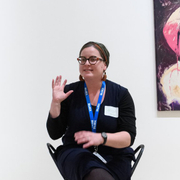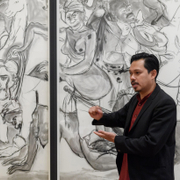- Level Foundation
- المدة 15 ساعات hours
- الطبع بواسطة The Museum of Modern Art
-
Offered by

عن
This course is designed to help build critical skills that support theme-based teaching practices and build confidence in incorporating modern and contemporary art into interdisciplinary lesson plans. By addressing themes and questions that arise in relation to modern and contemporary art, the course will help you to think creatively about links to your curriculum and the ways that you can tap into students’ knowledge and life experience. In this course, you will explore four themes that educators at The Museum of Modern Art use frequently in their teaching: Places & Spaces, Art & Identity, Transforming Everyday Objects, and Art & Society. Through videos, slideshows, and a variety of resources, readings, and activities, you will explore the content and context of works of art in MoMA’s collection. Learners will… - Explore works of modern and contemporary art through a variety of themes that relate to classroom content and student experience. - Hear directly from artists about their ideas and processes. - Learn about the ways that a thematic approach supports interdisciplinary teaching and learning. - Gain exposure to a range of digital resources available for teaching with themes and incorporating content around works of art into your classroom.الوحدات
What is Teaching with Themes?
2
Videos
- Introduction to Art & Ideas
- How to Teach with Themes
1
Readings
- Welcome to the Course!
Read & Review
1
Assignment
- Introduction to Teaching with Themes
5
Readings
- Optional Readings & Additional Resources
- Art, Ideas, and Social Emotional Learning
- Optional Prompts for Discussion & Reflection
- Tell Us About You
- Are you a New York State educator?
Overview
2
Videos
- Places & Spaces
- Teaching with Themes: Places & Spaces
1
Readings
- Introduction to Places & Spaces
Real & Imaginary Places
3
Videos
- Piet Mondrian. Broadway Boogie Woogie. 1942–43
- Martin Wong. Stanton near Forsyth Street. 1983
- Zarina. Home is a Foreign Place. 1999
1
Readings
- How do artists choose to represent the world?
Experiencing Place
3
Videos
- Claude Monet. Water Lilies. 1914-26
- Andrew Wyeth. Christina's World. 1948
- Emeka Ogboh. Lagos State of Mind. 2017/2020
1
Readings
- How do artists capture the mood of a place?
Reimagining Place
2
Videos
- Gordon Matta-Clark. Bingo. 1974
- Teddy Cruz, Fonna Forman. Manufactured Sites: A Housing Urbanism Made of Waste/Maquiladora, project (Model: 2005). 2005-08
1
Readings
- How do artists reimagine architecture?
Read & Review
1
Assignment
- Places & Spaces
2
Readings
- Optional Readings & Additional Resources
- Optional Prompts for Discussion & Reflection
Overview
2
Videos
- Art & Identity
- Teaching with Themes: Art & Identity
1
Readings
- Introduction to Art & Identity
Identity & Portraiture
2
Videos
- Henri Matisse. The Red Studio. 1911
- Frida Kahlo. Self-Portrait with Cropped Hair. 1940
1
Readings
- How do artists represent their sense of self?
Identity & Relationships
3
Videos
- Gilbert Baker. Rainbow Flag. 1978
- Catherine Opie. Being and Having. 1991
- Rineke Dijkstra. Almerisa series. 1994–2008
1
Readings
- How do artists represent others?
Challenging Identity
3
Videos
- Lorna Simpson. Wigs (Portfolio). 1994
- Kay WalkingStick. You’re an Indian? 1995
- Amira Virgil. The Melanin Pack for The Sims 4. 2016
1
Readings
- How do artists challenge identity?
Read & Review
1
Assignment
- Art & Identity
4
Readings
- Optional Readings & Additional Resources
- Optional Prompts for Discussion & Reflection
- Mid-course survey
- Reminder: CTLE for New York State educators
Overview
2
Videos
- Transforming Everyday Objects
- Teaching With Themes: Transforming Everyday Objects
1
Readings
- Introduction to Transforming Everyday Objects
Transforming How Objects Look
2
Videos
- Ruth Asawa. Untitled (BMC. 145, BMC Laundry Stamp). C. 1948-49
- Robert Rauschenberg. Bed. 1955
1
Readings
- How do artists draw from their surroundings?
Transforming What Objects Mean
3
Videos
- Alfonso Ossorio. Empty Chair or The Last Colonial. 1969
- Doris Salcedo. Atrabilious. 1992–93
- Diamond Stingily. Entryways. 2021
1
Readings
- How do artists alter the meaning of objects?
Transforming What Objects Do
3
Videos
- Clara Porset. Butaque Chair. C. 1957
- Tomás Gabzdil Libertiny. The Honeycomb Vase “Made by Bees” (Prototype). 2006
- Jessica Rosenkrantz, Jesse Louis-Rosenberg. Kinematics Dress. 2013
1
Readings
- How do designers problem-solve?
Read & Review
1
Assignment
- Transforming Everyday Objects
2
Readings
- Optional Readings & Additional Resources
- Optional Prompts for Discussion & Reflection
Overview
2
Videos
- Art & Society
- Teaching with Themes: Art & Society
1
Readings
- Introduction to Art & Society
Documenting Society
3
Videos
- Dorothea Lange. Migrant Mother. 1936
- Jacob Lawrence. Migration Series. 1940–41
- Carolina Caycedo. Spirals for Shared Dreams. 2022
1
Readings
- How do artists respond to social conditions?
Challenging Society
2
Videos
- Ernest Cole. Untitled. C. 1960
- Martha Rosler. House Beautiful (Bringing the War Home). 1967-72
1
Readings
- How do artists challenge social conditions?
Shifting Perspectives
3
Videos
- Hanes, Inc. White T-Shirt. 1910s
- Faith Ringgold. American People Series #20: Die. 1967
- Shahzia Sikander. Candied. 2003
1
Readings
- How do artists shift perspectives?
Read & Review
1
Assignment
- Art & Society
2
Readings
- Optional Readings & Additional Resources
- Optional Prompts for Discussion & Reflection
Reflect & Test Your Knowledge
1
Assignment
- Final Project: Design a Theme-Based Lesson
3
Readings
- Optional Prompts for Discussion & Reflection
- End-of-course survey
- CTLE for New York State educators
Before You Go: Additional Teaching Resources
3
Readings
- MoMA Resources
- Virtual Event Recordings
- Tips for Teaching Remotely
Auto Summary
Explore the intersection of art and education with "Art & Ideas: Teaching with Themes." This foundational course, led by Coursera, covers themes like Places and Spaces, Art and Identity, Transforming Everyday Objects, and Art and Society. Perfect for educators looking to enrich their curriculum and connect with students' experiences. Available through Starter and Professional subscriptions, the course spans 900 minutes. Ideal for those in the Arts & Humanities domain.

Larissa Raphael

Francis Estrada

Lisa Mazzola

